Believe it or not, not only do French people eat a lot of pizza—a 2016 study said they were the largest consumers of pizza in the world (possible paywall)—but French people also eat a lot of pasta. During our first Covid lockdown, the pasta aisle was one of the first—and one of the only—supermarket aisles to get completely wiped out.
But orzo, a rice-shaped pasta, is a rarity, so I was happy to find a box at Auchan labeled avoines, or “oatmeal.” Since orzo means “barley” in Italian, you might think it’d be called orge in French, but I think avoine is a prettier word. Maybe it’s because orge is a little too close for comfort to ogre, or orgy? (No link to the latter…I’ll let you search for that one yourself.) With the way my mind works, or doesn’t, you’re probably not surprised that I gave up on Wordle after the third try.
Often when I ask Romain why sometimes French grammar and spellings veer from the “rules,” he’ll reply, “Because it’s more beautiful to say it that way.” And I think we can all agree to make exceptions for beautiful things that come along in our lives.
To keep us on our toes, it’s also called risoni in France, which I just learned. Either way, the box of avoines that I had in my pantry was ready and waiting to be used, and this one-dish oven bake was the place to use it in.
“One pan” bakes, roasts, stews, and what-have-you, have become popular in the last few years. In her new book, One Pot, Pan, Planet, Anna Jones takes things in a greener, more ecological direction. We share the same publisher, who calls her “The queen of the greens.”
Thanks for the pandemic, we’ve all become a lot more familiar with doing dishes, and Anna joins a list of people who are continuing on the “one pan” or “one pot” theme, which I can get behind. A quick search of “one pot cookbooks” on Amazon revealed hundreds and hundreds of books on the topic. (Although I’m not sure how Keto Cocktails and The Essential Cookbook for Men figure into that mix.)
More and more people are trying to include plant options in their diet, along with eating less meat, even in France. Romain is one of those people, although much to my chagrin, he will not turn down a dish of andouillette. The last time he ate it, I had to wake him up in the middle of the night because the smell emitting from him was so strong that I couldn’t sleep. As for me, I’m much more inclined to choose to eat a dish of spinach, leeks, lemon, and pasta over a sausage that spills out odorous intestines when you cut into it. I know some people are opposed to plant-based meats, but in the case of andouillette, I’ll take the soy option.
When shopping for ingredients to make this, the green chilis (which she calls for) are rather mild in France, so I bought an unmarked red chili, which was hotter than h-e-double-toothpicks. I ended up using just a little bit of it because it was so hot. Someone online saw it and told me it looked like cayenne, which is possible. I like heat, but like the French, I don’t like it overwhelming the other flavors.
Chilis are a tough nut in the world of recipe-writing as one person’s hell is another person’s heaven. Local shoppers are not known for their love of hot chili peppers and whenever I buy them at the market, the vendor invariably assures me that it’s doux, and not pimenté. When I tell them, “I like spicy!” they’re a bit surprised but bag ’em up for me.
(Chilis that are very hot, that are easy to find in Paris, are piments Antillais, which you can find in multicultural neighborhoods. I think they are habaneros, which are very hot.)
When deciding on what chili to use, you can simply trust your instincts. Some of us have spent our lives doing that and I know you can do it with a chili pepper, as well as applying that same savoir-faire to what herbs you’d like to use, too.
I’ve been taken to the mat a few times for not making everything from scratch. (Hey, I did once make my own caviar…) However, for those who want to take the DIY route, preserved lemons are simple to make and nearly foolproof. The downside is they take a few weeks to preserve, so I keep a jar on hand from my local North African épicierie (food shop.) Unfortunately, I don’t know how to make orzo, so you’ll probably want to just buy that.
That said—and yes, here I get bragging rights—I did pick my own fennel seeds. Yes, I really did. The only thing is, I’m not really sure if they are fennel or green anise. I go back and forth on that.
Whether you grow, pick, and dry your own spices, or buy them, if you’ve made any of Yotam Ottolenghi’s recipes, you should have them on hand. (Shhhh…Don’t tell him I said that.)
But honestly, if you don’t have them, you can play around with others flavors, including swapping out the sumac with a bit of smoky paprika, or skip the coriander and fennel (or anise seed), and reach for something else in your spice cabinet. There are no judgments in my newsletter, and I don’t want anything to stand between you and this lovely, one-dish dinner that’s ready in less than an hour.
Baked Orzo with Spinach and Herbs
6 servings
Adapted from One Pot, Pan, Planet by Anna Jones
The coriander seeds add a nice flavor that’s a bit hard to put your finger on, but if you don’t have them, you can play around with another seasoning (like a dusting of nutmeg) or leave it out. The ground sumac powder is pretty delicious, as it has a nice tang, so it’s worth tracking down. This can also be made with arugula, which is easy to find in France. The smaller-leaf variety is more tender, but if you have larger leaves, you can chop them up a bit first.
Onions can fill in for leeks and extra fresh lemon zest could fill in for the preserved lemon, although it’s not the same flavor.
No need to fret over the shape of the baking dish. It doesn’t really matter. I used an oval gratin dish, but you can use a square or rectangular one. One that’s about 12 inches (30cm) long should do it.
2 medium leeks, trimmed (tough dark green stalks removed), and washed very well, then sliced
2 tablespoons extra-virgin olive oil
Juice of one lemon (zest it first, which you’ll use for finishing the dish)
1 teaspoon coriander seeds, ground
1/2 teaspoon of fennel or anise seeds
1 mild green chili pepper, stemmed, seeded, and finely diced, or another favorite chili pepper, used as you wish
4 ounces (115g) baby spinach or arugula
12 ounces (scant 2 cups, 340g) orzo pasta
4 cups (2 ounces) loosely packed mixed soft fresh herbs, such as parsley, dill, tarragon, mint, and cilantro, very coarsely chopped
1 3/4 cups (400g) plain whole-milk yogurt
1 large egg
1/2 preserved lemon, insides scooped out (pulp discarded), rind finely diced
1 teaspoon sumac, plus a bit more for finishing the dish
1 3/4 (425ml) cups boiling water
Zest of 1 lemon (previously mentioned)
4 scallions, finely sliced
Feta cheese*, optional
Preheat the oven to 450ºF (230ºC).
In a 12-inch (30cm) baking dish with relatively high sides, toss the leeks with the olive oil, the juice of half a lemon, the ground coriander, the fennel or anise seeds (I left the seeds whole), the chopped chili, and season with salt and freshly ground black pepper. Cover tightly with foil and bake until the leeks are wilted and tender, about 20 to 25 minutes.
While the leeks are baking, in a large bowl, stir together the baby spinach or arugula with the orzo, half of the chopped herbs, yogurt, egg, diced preserved lemon, and sumac.
Remove the leeks from the oven and remove the foil. Stir in the spinach mixture along with the boiling water. Stir well, cover again with the foil, and bake for another 25 minutes.
Remove the dish from the oven and remove the foil. Squeeze or sprinkle the remaining lemon juice over the top and return to the oven and bake for a few minutes until the edges are gently browned, about 5 to 7 minutes.
Remove from the oven and let stand 5 minutes. Scatter the remaining fresh herbs, the lemon zest, and the sliced scallions over the top, and sprinkle with additional sumac. If desired, crumble feta cheese over the top and serve.
*When I reheated this for leftovers, I sprinkled some feta on top, which was a great addition, although not shown in the photos, which were taken when I first served this.
Note: Good sources for sumac include Kalustyan’s, Diaspora, Burlap & Barrel, and La Boîte. Many spice stores sell it, but beware that I’ve read that some sumac is cut with beets so it doesn’t have the same assertive tang that the real deal has.
This post is for all subscribers. Thanks for subscribing!
If you’d like to upgrade to a paid subscription to get all posts, recipes, and stories, you do so so here:







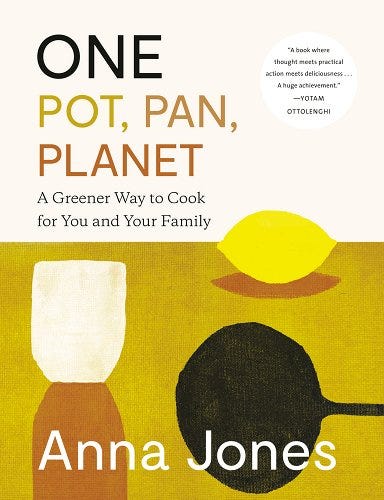
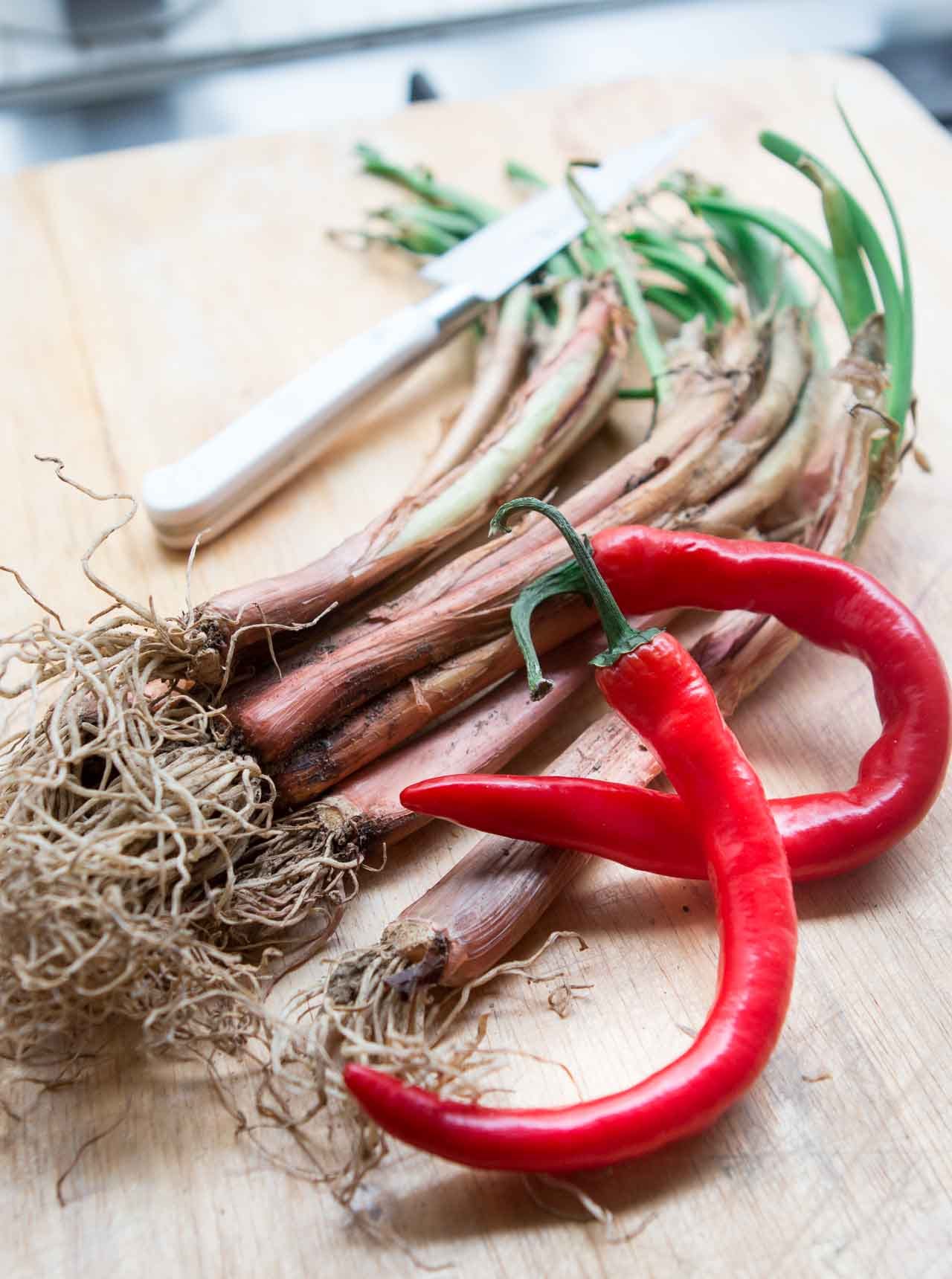

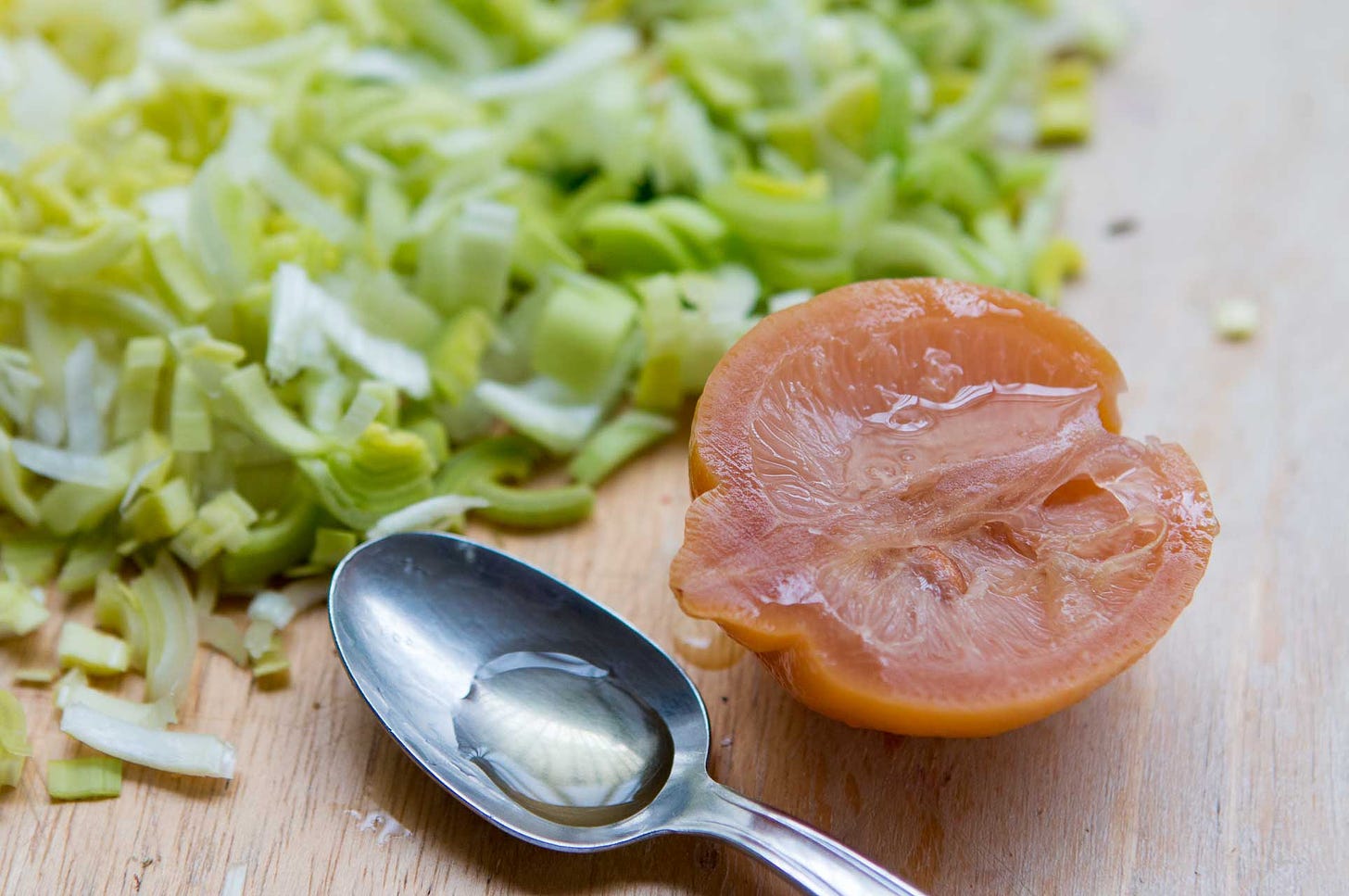
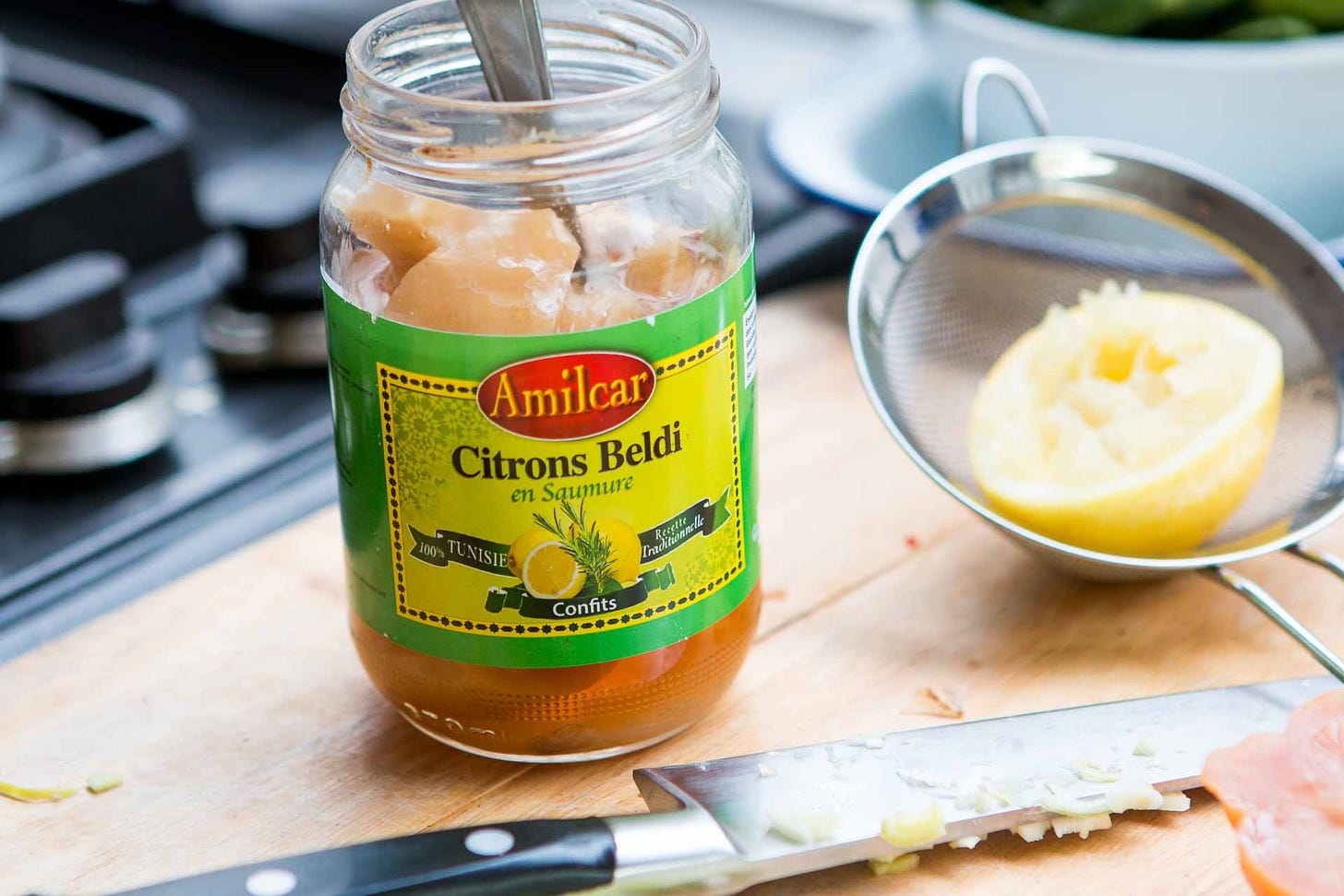

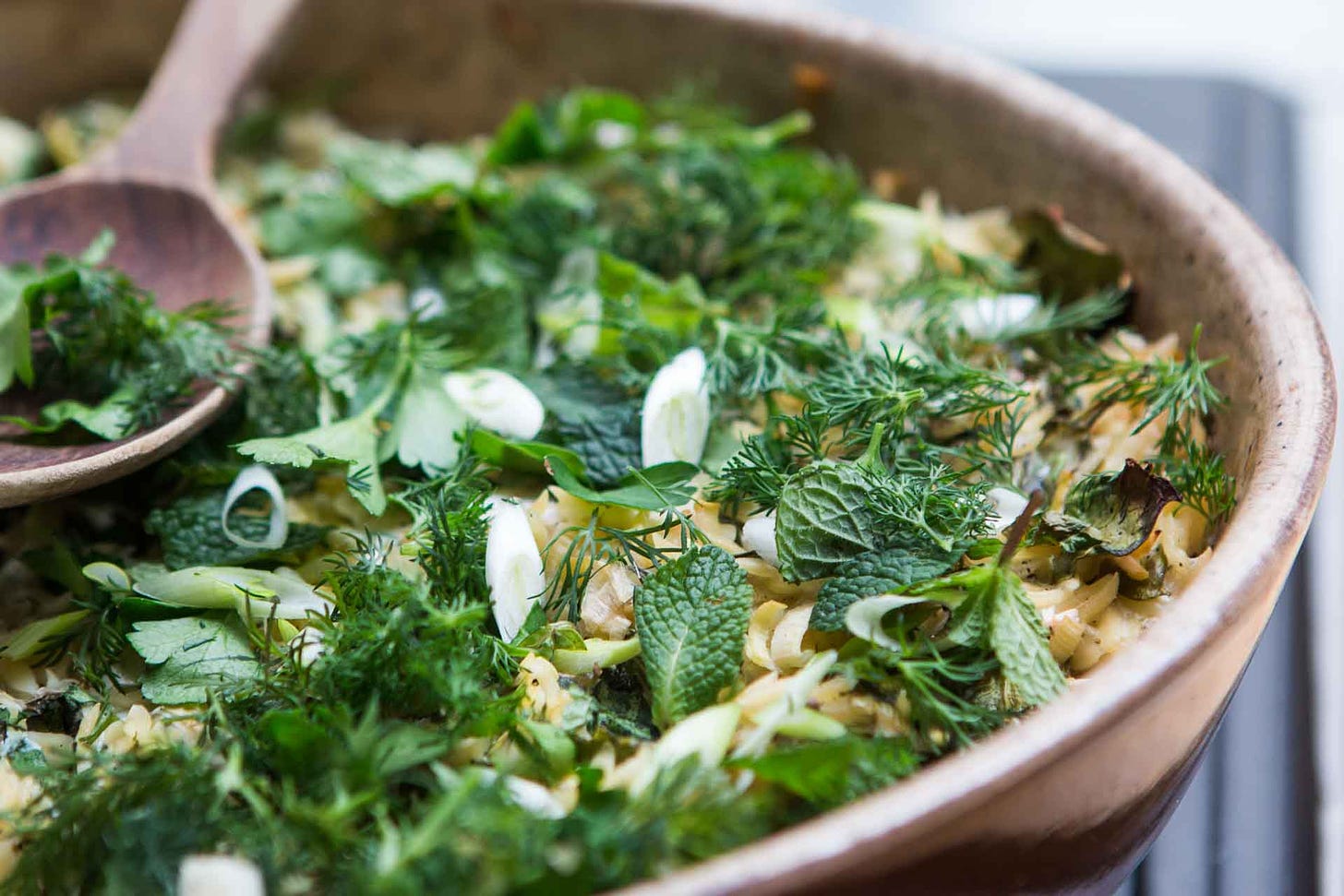
Sounds delicious! Orzo is also called 'langues d'oiseaux' (bird tongues) in French. Our favourite traiteur in Rennes sometimes makes an appetiser in a little verrine with langues d'oiseaux and langoustines.
Well I made it and it was absolutely delicious! Used mint, tarragon and parsley. I followed the directions but forgot to add the chile (I caught it angrily staring up at me from the counter when the whole thing was already in the oven). I confess, I did not miss it. A sprinkle of herbs on top with feta and the lemon zest was just the perfect touch. I’ll be making this again. Thank you!